Grant Types and Past RecipientsAll applications will be automatically considered for the following awards. The awardees will be selected by the committee based on the merit of the proposal. Awardees will be recognized in the Paleontological Society Newsletter, Priscum. Have you received a grant in the past? Please fill out this questionnaire. Named AwardsPresident's Student Research AwardsThe several top-ranked proposals will be recognized as President's Student Research Awards. Richard K. Bambach AwardAll applications will be considered for two Bambach Student Research Awards. ESCONI AwardAll applications will be considered for the Earth Science Club of Northern Illinois (ESCONI) Award, but preference will be given for student research on the Paleozoic of the midwestern United States. Elso Barghoorn AwardThis award honors the scientific career of Elso Sterrenberg Barghoorn, Jr, (1915-1984), who is renowned for his contributions to Archean and Proterozoic paleontology and Phanerozoic paleobotany. In many ways a man ahead of his time, he championed the careers of women paleontologists and biologists, among them the evolutionary biologist Lynn Margulis (1938-2011), best known for her pioneering work on endosymbiosis. All applications will be considered for an Elso Barghoorn Student Research Award, but preference will be given to projects that involve paleobotany or Archean and Proterozoic paleontology. Arthur J. Boucot AwardThe Boucot Award was established by the Paleontological Society in recognition of Art Boucot’s generosity to the Society. All applications will be considered for a Boucot Student Research Awards. Kenneth E. & Annie Caster Award
Ken, as teacher, supervised at least 30 master and 25 doctoral students. He was given a variety of awards, including the Orville A. Derby Medal of the Brazilian Geological Survey, the Gondwana Medal of the Geological Survey of India, the Paleontological Society Medal, and received both Guggenheim and Fullbright fellowships. Ken was President of the Paleontological Society, three times President of the Paleontological Research Institution, and in 1975, his students presented him with a Festschrift volume in honor of his 45th year of teaching. G. Arthur Cooper AwardThe Cooper Award was established by Richard Bambach in honor of G. Arthur Cooper. All applications will be considered for a Cooper Student Research Award. Rodney M. Feldmann AwardAll applications will be considered for two Feldmann Student Research Awards. Elvira and Bob Gastaldo Deciphering Earth History Award in Applied PaleobotanyFunds will support paleobotanical studies that focus on the application of terrestrial and aquatic plants to the fossil record and history of life. Studies include, but are not limited to: plant taphonomy, paleoecology, ecosystem evolution and response(s) to perturbation, refining paleoclimate proxies, palynofacies and dispersed organic matter, and other techniques yet to be developed which fall under the broad umbrella of applied paleobotanical research. Stephen Jay Gould AwardThis award recognizes the vast and wide-ranging contributions of Stephen Jay Gould (1941-2002): to paleontology, evolutionary biology, and the history and philosophy of science; to the popularization of science and natural history through his numerous essays and books written for the general public; and as a generous colleague and mentor. All applications will be considered for a Gould Student Research Award. However, consistent with Steve’s focus on the nature and meaning of history, particularly evolution, preference will be given to (macro)evolutionary studies. Leo J. Hickey Award
F.D. "Bud" Holland, Jr., AwardFrank Delno Holland, Jr. (1924 - 2023), known to his many friends as “Bud,” was a broadly educated paleontologist and stratigrapher specializing in invertebrates but able to work with and to teach fossil groups from protists to dinosaurs. He shared a love of the history of geology, high quality teaching, and mentoring with his students. Bud’s professional career spanned four decades at the University of North Dakota, during which he published extensively on the Devonian, Cretaceous, and Cenozoic paleontology of the upper Midwest. This work and his vast knowledge of paleontology formed the basis for infusing his students with an encyclopedic knowledge and enduring love of paleontology, especially the importance of systematics. He devoted his career to preparing the next generation of students, who were also often supported by his wife Margine “Mardi” McVey Holland. Preference for this award will be given to students whose primary interest is the morphology and systematic relationships of fossil invertebrate organisms. H. Richard Lane AwardAll applications will be considered for H. Richard Lane Awards. N. Gary Lane Award
Richard Osgood AwardThe Osgood awardee shall undertake a project that integrates knowledge of natural history and behavior of modern animals with observations derived from the fossil and stratigraphic record. The committee will assign the Osgood Award to the successful proposal that most nearly meets these criteria. Allison R. “Pete” Palmer AwardAll applications will be considered for two Palmer Student Research Awards. James M. & Thomas J. M. Schopf AwardThe Schopf Award was funded by a gift from Bill Schopf to honor the memories of James M. Schopf of the U.S. Geological Survey and The Ohio State University, Paleontological Society Medalist, and Thomas J. M. Schopf of the University of Chicago, winner of the Paleontological Society’s Charles Schuchert Award. Steven M. Stanley AwardThe Stanley Award was established by the Paleontological Society in recognition of Steve Stanley’s generosity to the Society. All applications will be considered for a Stanley Student Research Awards. Robert J. Stanton & James R. Dodd AwardThe Stanton & Dodd Award was established by Cheryl Metz to honor the fruitful collaboration of Bob Stanton and Bob Dodd. All applications will be considered for a Stanton & Dodd Student Research Award. Harry B. Whittington AwardAll applications will be considered for a Whittington Student Research Award. Ellis L. Yochelson – Yochelson Student Research Awards
His historical studies included the epic two-volume biography of Charles D. Walcott, the 75th anniversary volume of the National Museum of Natural History (USNM), and his 2004 study of “…Natural History in Washington.” Ellis’ bibliography has at least 300 entries. Ellis had a lifelong interest in natural history. He joined the U.S. Geological Survey in 1952 and had his laboratory at the United States National Museum of Natural History, Smithsonian Institution. After retirement in 1985, he continued at the USNM as a Research Associate and Scientist Emeritus for the rest of his life. Ellis, and his wife Sally, hosted innumerable colleagues and students who came to the USNM to study. Ellis was President of the Paleontological Society, he founded the Society’s annual short courses in 1978, and in 1969 he arranged the first North American Paleontological Convention (NAPC). The 2001 NAPC in Berkeley was dedicated to him. In 2003, he received the Award of the History of Geology Division of the Geological Society of America. Yochelson Ridge, in the Heritage Range of the Ellsworth Mountains, was named for him in honor of his Antarctic work. (See, 2007, American Paleontologist, v. 15, No. 1, p. 11). All applications will be considered for four Yochelson Student Research Awards. If you have any questions about applications or the submission process for grants, please contact [email protected] Paleontological Society Student Award Winners2025 Student Award WinnersNiko Balan for project "The Effect of Seawater Temperature on Growth Rates of Non-Tropical Reef-Building Coral Cladocora Caespitosa During the Mid-Pliocene Warm Period" Colin Boisvert for project "The phylogenetic relationships of New Mexico allosaurids" Malton Carvalho Fraga for project "Pyritization in fossil echinoderms: insights from diagenetic experiments" Daniel Cline for project "Chondrichthyan Diversity across the Carboniferous-Permian Boundary of North America" Alejandro Corrales-García for project "Reconstructing Cambrian Seafloors: The Ichnology of Burgess Shale-Type Deposits" Emily Cross for project "Trophic Response to the Cretaceous Thermal Maximum in Mongolia's Gobi Basin" Kiera D. Crowley for project "Investigating the ecological and developmental dimensions of a post-extinction radiation in Ordovician Silurian crinoids (Superorder Flexibilia)" Jenna Dagher for project "Enamored with Enamel: Stable Isotopes of Olduvai Gorge" Caitlyn Dempsey for project "Growth in a warm polar ocean: intrannual banding in Eocene bivalves from Antarctica" Franklin Duffy for project "Environmental impacts on body size variation in Late Devonian stem-tetrapods from Western North America" Danielle Fitzgerald for project "Reconstructing the earliest macroscopic life forms with complex morphologies" Owen Goodchild for project "Transforming understanding of North American Gomphotherium (Proboscidea, Mammalia) taxonomy, phylogeny, and biogeography with 3D data" Venu Gopal Kella for project "Investigating the growth response of Early Miocene Pectinids to onset of Indian Summer Monsoon and tropical salinity fluctuations: A sclerochronological approach" Samantha Hartzell for project "Scleractiniamorphs: Clarifying potential Paleozoic origins of modern Scleractinia" A. Kade Hensley for project "Shrew Are You? Investigating the foraging ecology and extinction chronology of island shrews from southern Haiti through isotopic and temporal analyses" Theodore Herring for project "Testing Perognathus phylogeographic hypotheses and niche conservatism using the fossil record" David Iglesias for project "Fossil Wood description and paleoenvironmental interpretations of the Pebas Formation in Rio Napo, Nanay, and Orán regions" Christian Jackson for project "Distinguishing alethopterid from neuropterid Myeloxylon in permineralized plant assemblages" Gretl King for project "Plankton macroevolutionary processes related to Hadley Cell dynamics across the Miocene Climate Optimum in the Tasman Sea" Peter Liberty for project "Characterizing the Ecologies of Late-Ediacaran Reefs" Gabriel Ricardo López-Isla for project "Vertebrate tracks from the Yacoraite Formation (Quebrada de Humahuaca, Argentina): a megatracksite perspective" Zhengbo Lu for project "High-resolution foraminiferal diversity and mechanisms in the Paleogene" Kevin D. Mulcahy for project "Quantitative Analysis of Sexual Dimorphism in the Extinct Mammalian Order Dinocerata" Mark Nohomovich for project "The importance of microvertebrates and their use in assessing the evolution of the anuran body plan and its role in locomotion" Zaid Qureshi for project "Feeding strategies in Cambrian sponges: Archaeocyaths of the Forteau Formation, Labrador, Canada" Belal Salem for project "Investigating Morphological Adaptations and Paleobiogeography of Dyrosaurid Crocodyliforms from the Late Cretaceous of North Africa" Lukas Schweigl for project "Evolution of primary productivity in the northern Adriatic Sea during the Holocene as an analog for present and future ecosystem change" Spencer Shroyer for project "Using ecological gradients in offshore facies to establish sequence stratigraphic architecture: Pennsylvanian Breathitt Group of eastern Kentucky, U.S.A." Valor Nikesha Smallwood for project "Rancho La Brea Wolf Habitat Use and its Link to Extinction Selection" Andrei-Alexandru Smeu for project "Correlation of Geochronological Data with Calcareous Nannofossil Ranges in the Miocene Deposits of Paratethys (Romania)" Kathryn Sokolowski for project "Resolving herbivore diets in Pleistocene South Africa using dental microwear" Ella Stewart for project "Invertebrate fauna of the Strait of Juan de Fuca can shed light on the paleoenvironment of the desmostylian Behemetops proteus" Kayli Stowe for project "Re-evaluating the ecological and macroevolutionary history of a vanished seaway: the Mio-Pliocene San Joaquin Seaway in California's Central Valley" Haley Vantoorenburg for project "Examining the Affinities and Taphonomy of Enigmatic Cloudinomorph Fauna from the early Cambrian of Estonia Using X-Ray Microanalysis" Mariana Vilela de Andrade for project "How did Devonian marine communities of Brazil respond to the Daleje and Kačák biocrises?" Niall Whalen for project "Phytolith-Based Investigation of Ecological Turnover Following the End-Cretaceous (K-Pg) Mass Extinction" Liana Wijetunga for project "Investigating Taphonomy and Replacement Mineralization Of Curious Green Bivalves Near The Triassic - Jurassic Boundary, Sheep Mountain, WY" Brynn Wooten for project "A Paleoecological Interpretation of the North American "Hell Pig" (Archaeotherium)" Alysha Zazubec for project "Unraveling Monobathrid (Echinodermata) Phylogenetics Across the Ordovician Extinction"
2024 Student Award Winners Kemi Ashing-Giwa for project "The Good, the Bad, and the Euxinic: The Role of Sulfide During the End-Permian Mass Extinction" Cooper Caputo for project "Testing hypothesized long-distance oceanic foraging in pterosaurs using isotopic analyses" Andres F. Alfonso-Rojas for project "Using new fossil discoveries to reconstruct the diversification of South American snakes in relation to environment and functional traits" Evan Ritchey for project "Reexamined controls on microbial and skeletal modes of carbonate sedimentation" Henry Thomas for project "Quantifying large dicynodont diversity in late Permian South Africa" Megan O'Quin for project "Documenting Historical Decline of Jamaican Coral Reef Ecosystems" Cassius Morrison for project "Investigating changes within medium-to large sized predatory theropod dietary guilds during the Cretaceous and the impact on terrestrial ecosystems" Edward Medeiros for project "What do biomechanics tell us about the ecology of the giant Eocene whale Basilosaurus?" Colby Higdon for project "Characterization of feeding ecology in Late Ordovician paracrinoids and rhombiferans" Ajani Bissick for project "Morphological Classification of Thrombolites from the Urusis Formation in Southern Namibia" Ian James Forsythe for project "Quantifying the Paleoecological Impacts of the Clarksville Phase of the Richmondian Invasion in the Nashville Dome, TN" Andy Danison for project "A Reevaluation and Osteohistological Analysis of the Giant Jurassic Theropod Saurophaganax maximus" Matthew Philip Craffey for project "Testing Ecological Succession by Bioturbation in the Late Ediacaran" Dánae Sanz Pérez for project "Paleoecology from Pleistocene brown bears through bioapatite stable isotopes (Portugal, Iberian Peninsula)" Louis-Philippe Bateman for project "Chronological, Dietary, Morphological, and Palaeoclimatic Analysis of Quebec's Second Ever Extinct Megafauna Fossil" Christianne Ormsby for project "Paleoecology of late Miocene carnivorans (Machairodontinae and Hyaenidae) from Kenya and the assembly of eastern Africa‚ a late Cenozoic large carnivore guild" Selena Martinez for project "Quantifying palatal tooth complexity and function in fossil terrestrial animals" Gavin Long for project "Aberrant Conodont Morphotypes from the Late Devonian Lower Kellwasser Event" Miriam Kane for project "A Phylogenetic Analysis of Sharks in the Neogene from the East U.S. Coast" Edward J. Spagnuolo for project "Testing Sunda-Sahul floristic exchange hypotheses using new macrofossils from Eocene Borneo" Bri Heisler for project "The Contributions of Sexual Selection to the Extinction of the Paranthropus Genus" Karen Pham for project "Influences on past baobab survival in Velondriake, Southwest Madagascar: A conservation paleobiology study" Jordan Todes for project "Evaluating the microstructure, geochemistry, and diagenesis of linguliform bioapatite: a comparison of modern and Paleozoic linguliform brachiopods" Martin Welych-Flanagan for project "Testing for Synchronous Ecological Evolutionary Patterns Across the Middle Devonian Appalachian and Illinois Basins" Maya Roselli for project "SOFT BODIED FOSSILS AND REDOX CONDITIONS OF THE DEVONIAN APPALACHIAN BASIN" Brian Beaty for project "Bioturbation and Nutrient Cycling Across the Permian-Triassic Extinction" Emily Hauf for project "Integrated conodont-carbon isotope bio-chemostratigraphy and magnetic susceptibility analysis of dynamic biotic and climatic change across the Kinderhook-Osage boundary" Jonathan Keller for project "Changing climate and megafaunal extinction cause big impacts for small mammals" Isaura Aguilar-Pedrayes for project "Tooth complexity and feeding efficiency: Tracing the evolution of ornithischian dinosaurs" Sarah Saxton Strassberg for project "Fossoriality and digging mode across the Paleogene-Neogene boundary" Maxime Grosmougin for project "Evolution of the Wing Shape and Ancestral Reconstruction of the Flight and Locomotor styles in Paraves (Dinosauria: Pennaraptora) using Geometric Morphometrics" Abi Crane for project "Medullary Bone in Three Dimensions" Caroline P Abbott for project "Ontogenetic trajectories of Lystrosaurus (Therapsida, Anomodontia) species in the Karoo Basin, South Africa during the End Permian Mass Extinction" Stephanie Richter Stretton for project "Determining the mechanisms of 3D preservation in the Emu Bay Shale, Kangaroo Island, South Australia" Emily McKenzie for project "Calibration and application of the mercury geochemical proxy in long nose gar scales: Resolving the driver of the Paleocene-Eocene Thermal Maximum" Grace Burns for project "Paleoclimate reconstruction with Middle Miocene scallops as an analog for current climate change impact on modern scallops" Wentao Zheng for project "A late Tonian Lagerstatte: Pickled vase-shaped microfossils from the Chuar Group, Grand Canyon, USA" Arion Chao for project "Blind Worms to World Serpents, the Evolution of Jaw Functional Performances Across the Squamate Tree of Life"
2023 Student Award Winners Alavya Dhungana for project "Squaring the roundworm with Cambrian fossils" Alexander Bradley for project "Ontogenetic Sequence Analysis of Fossil Arthropods" Alexandra Pamfilie for project "Spatiotemporal morphological stability in the American mink (Neogale vison)" Ben Rodwell for project "Estimating activity pattern in fossil primates using maxillary morphology" Cade Orchard for project "Nonmarine stratigraphy and community response to transgression:a test in the Cloverly Formation of Wyoming" Carmi Milagros Thompson for project "Changes in trophic structure of fossil gastropod communities from the southwestern Caribbean during the late Neogene" Chelsea M Comans for project "δ18Op of Late Cretaceous shark enameloid: a proxy for paleohabitat evaluation" Dakota Maverick for project "The reexamination of Mazon Creek medusae using Microcomputed Tomography" Emily McKenzie for project "Mercury geochemistry of fossil gar scales across the Paleocene-Eocene thermal maximum: Novel insights into bioaccumulation and sources from the North American interior" Ernesto Vargas-Parra for project "More than the sum of its parts: modularity in a trilobite family over an evolutionary radiation" Galadriel Freeman Peters for project "Impact of Competition on Epibiont Community Structure from the Ordovician to Devonian" Giovanni Mussini for project "Cambrian life in shallow waters: mapping the Small Carbonaceous Fossil (SCFs) of the Grand Canyon National Park, Arizona" Hunter Olson for project "Understanding Preservation of Soft-Bodied Fossils in the Middle Cambrian of Montana" Jennifer K. Crowell for project "Investigations of Dinosaur Swim Tracks of the Moenave Formation, St. George, Utah" Jensen Wainwright for project "Stable isotope analysis of fossil rodent diet: Implications for the reconstruction of Hominin paleoenvironments" Josh Hedge for project "Investigating Oviraptorosaur Nesting Behavior with Novel Quantification of External Eggshell Surface Ornamentation" Kate Pippenger for project "Reconstructing the rise of bioturbation in the mid-Paleozoic Appalachian Basin" Kentaro Layton for project "Baculitid phylogenetic reconstruction from a Bayesian perspective" Luis Torres Jr. for project "Comparative Taphonomy of Mollusk Shells and Echinoid Tests" Marcelo Schereiber Munhoz for project "A survey of bioacoustics inside paleoburrows: a new approach" Marcos Amores for project "Unraveling the causes of delayed vegetation recovery after the end-Permian extinction (EPE)" Mark Nikolic for project "Phylogenetic comparative assessment of developmental variability in a trilobite order" Maya Samuels-Fair for project "High-throughput analysis of spatial diversity gradients in bryozoan ecology at the exceptional Cretaceous-Paleogene boundary site Stevns Klint (Denmark)" Melissa Wood for project "Predicting patterns of vertebrate fossil preservation using variation in rates of stratigraphic accumulation: a case study in the Washakie Formation, WY" Minyoung Son for project "Phylogeny in an Ontogenetic Framework: Heterochrony in Ceratopsian Dinosaurs" Nathan Christopher Platt for project "Goniopholidids of North America" Prescott Vayda for project "Exploring Temperatures during the Cambrian Explosion using Oxygen Isotopes of Phosphatic Small Shelly Fossils" Rachel Lorraine Surprenant for project "Characterizing sedimentological packaging of shallow marine siliciclastic facies through time: assessing the interplay between matground distribution, bioturbation extent, and the nature of the stratigraphic record" Rhiannon Nolan for project "Earth System Succession in the Aftermath of the end-Cretaceous Mass Extinction" Sarah Jamison-Todd for project "Osedax Bioerosion on Marine Tetrapod Bone: Evolution of an Ecosystem Engineer" Savannah E Cobb for project "Using deep learning to classify ‘honing premolars’ by sex and diet" Shannon K. Brophy for project "Were cold seeps a refuge during Oceanic Anoxic Event 2 in the Western Interior Seaway?" Sienna Siu for project "Crystal Puzzle: Bivalve Biomineralization Toolkit for Abrupt Environmental Changes" Sinjini Sinha for project "Ecological response to the Early Jurassic climate crises in Morocco" Stephanie M. Palmer for project "Insights into aquatic transitions through carnivoran comparative endocranial morphology" Tessa Brunoir for project "Testing Phanerozoic sponge fossils for purported Precambrian molecular fossil" Walker Weyland for project "Springtime in the Precambrian: Comparing Community Composition for Evidence of Reproductive Strategies in Early Multicellular Ecosystems" William Foster for project "A re-description and re-analysis of Claudiosaurus germaini"
2022 Student Award WinnersWilliam Freimuth for project “Exploring growth and variation in the early-diverging therizinosaurian Falcarius utahensis (Dinosauria: Maniraptora).” Emerald Bender for project “A reanalysis of Hadrosauridae using Bayesian optimality criterion for the recovery of more confident interrelationships among poorly supported clades”. Kathleen Grosswiler for project "Did the Wrangellia Large Igneous Province trigger an extinction and biotic revolution during the Carnian?." Shamindri Tennakoon for project "Morphological disparity and variability of the fossil gastropod Hystrivasum (Family Turbinellidae)." Frances Stephenson for project "The comings & goings of Bison antiquus in Big Bone Lick, Kentucky: an analysis of patterns in bison mobility." Thomas LaBarge for project "Application of stable nitrogen isotopes as proxy for trophic relationships of East African Pleistocene megafauna." Lynnea Jackson for project "Cranial description of a new basal sauropodomorph from the Early Jurassic of Antarctica." Sarah Leventhal for project "The rise of colonial division of labor and diversification in cheilostome bryozoans." Vikram Vakil for project "Size doesn't matter: Late Quaternary extinctions of Australia's small-bodied faunas." Alexandra Norwood for project "Environmental seasonality across Southern Africa at the Last Glacial Maximum." Eloise Hunt for project "Elucidating the drivers of Galloanserae evolution using high-resolution 3D imaging." Ezekiel King Phillips for project "Reconstructing the paleodiet of fossil snails from nitrogen isotopes in carbonate-bound organic matrix and carbon stable isotopes in calcium carbonate." Jacob Wilson for project "The effects of the Cretaceous-Paleogene extinction on freshwater fish." Jonas Zajonz for project "Dietary change in the life of Rapetosaurus krausei (Sauropoda: Titanosauria)." Kaedan O'Brien for project "Seasonality as a driver of ungulate migration patterns at the Late Pleistocene site of Kibogo, Kenya." Karen Pham for project "Effects of Holocene animal extinction on seed sizes of Malagasy Canarium." Kayla Irizarry for project "Did persistently low oxygen conditions slow diversification during the Cambrian?" Liam Norris for project "Insights into dinosaur ecology through isotope analysis of Sauropod teeth from the Morrison Formation." Lilja Carden for project "Dead shell assemblages as archives of eutrophication gradients: the future of nitrogen isotopes in estuarine monitoring." Claire Williams for project "Environmental influence on facies composition over time, Canada Honda Reef." Jordan Claytor for project "Mammalian dietary ecology during the post K-Pg recovery interval." Katherine J Jordan for project "Persistence in the face of extinction: a morphological examination of proetid trilobites." Katherine Turk for project "Investigating the potential animal origins of enigmatic late Ediacaran traces from Namibia." Malton Carvalho Fraga for project "Ophiuroid taphonomy: a proxy of event beds in Devonian mudrock sequences of Brazil." Marion Thaureau for project "Leanchoilids from the Fezouata biota." Michael Serio for project "Whole forelimb digital modeling in the Late Cretaceous Dinosaur Troodon formosus." Nidhi Utkarshbhai Patel for project "A spore-pollen record of terrestrial vegetation response to the Cretaceous-Paleogene boundary mass extinction event, Oyster Bay Formation, Vancouver Island, British Columbia, Canada." Samantha Arsenault for project "Paleoclimate aspects of an extinct, endemic land snail community at Ka'ena Point, O'ahu." Tengxiang Wang for project "Origins of modern vegetation in mainland Southeast Asia: Paleobotanical evidence from Vietnam." Annaka M. Clement for project "The adaptive radiation of the bivalve Monotis in the Late Triassic of New Zealand: environmental or biological drivers?" Anne Kort for project "Evolution of lumbar vertebrae in Paleogene mammals." Haley Vantoorenburg for project "Paleoecological trends in epibiont communities on Devonian brachiopods." Jaleigh Pier for project "Investigating the effects of harvesting on body size of the Eastern Oyster, Crassostrea virginica, within the Guana River Marsh Aquatic Preserve: A paleoecological approach." James Beech for project "Convergent evolution in enigmatic trilobites: the function and origins of the Harpetid Brim and Trinucleid Fringe." Julia Criscione for project "A morphological and phylogenetic analysis of early Sternorrhynchan insects from the Late Triassic Cow Branch Formation." Kelly Tingle for project "Making microfossils: Experimental taphonomy of protists." Nicholas S. Smith for project "Expanding our understanding of the Late Paleozoic record of fossil brittle stars using novel techniques." Luis Alejandro Giraldo Ceron for project "Did insect herbivores track Eucalyptus from Eocene Patagonia to modern Australasia?" Valerie Trinidad for project "Testing Triassic climatic variability and vertebrate distribution across southern Pangea with comparative histological analysis." |

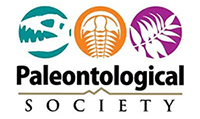
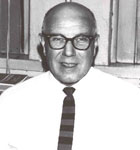 Kenneth E. Caster (1908-1992) was a renaissance paleontologist who researched fossils from sponges to eurypterids; he had especial affection for echinoderms and arthropods. In addition, he was an early proponent of the application of the facies concept to understanding stratigraphy, his work in the Southern Hemisphere convinced him that continents moved, and he was an ichnologist before the word was coined.
Kenneth E. Caster (1908-1992) was a renaissance paleontologist who researched fossils from sponges to eurypterids; he had especial affection for echinoderms and arthropods. In addition, he was an early proponent of the application of the facies concept to understanding stratigraphy, his work in the Southern Hemisphere convinced him that continents moved, and he was an ichnologist before the word was coined.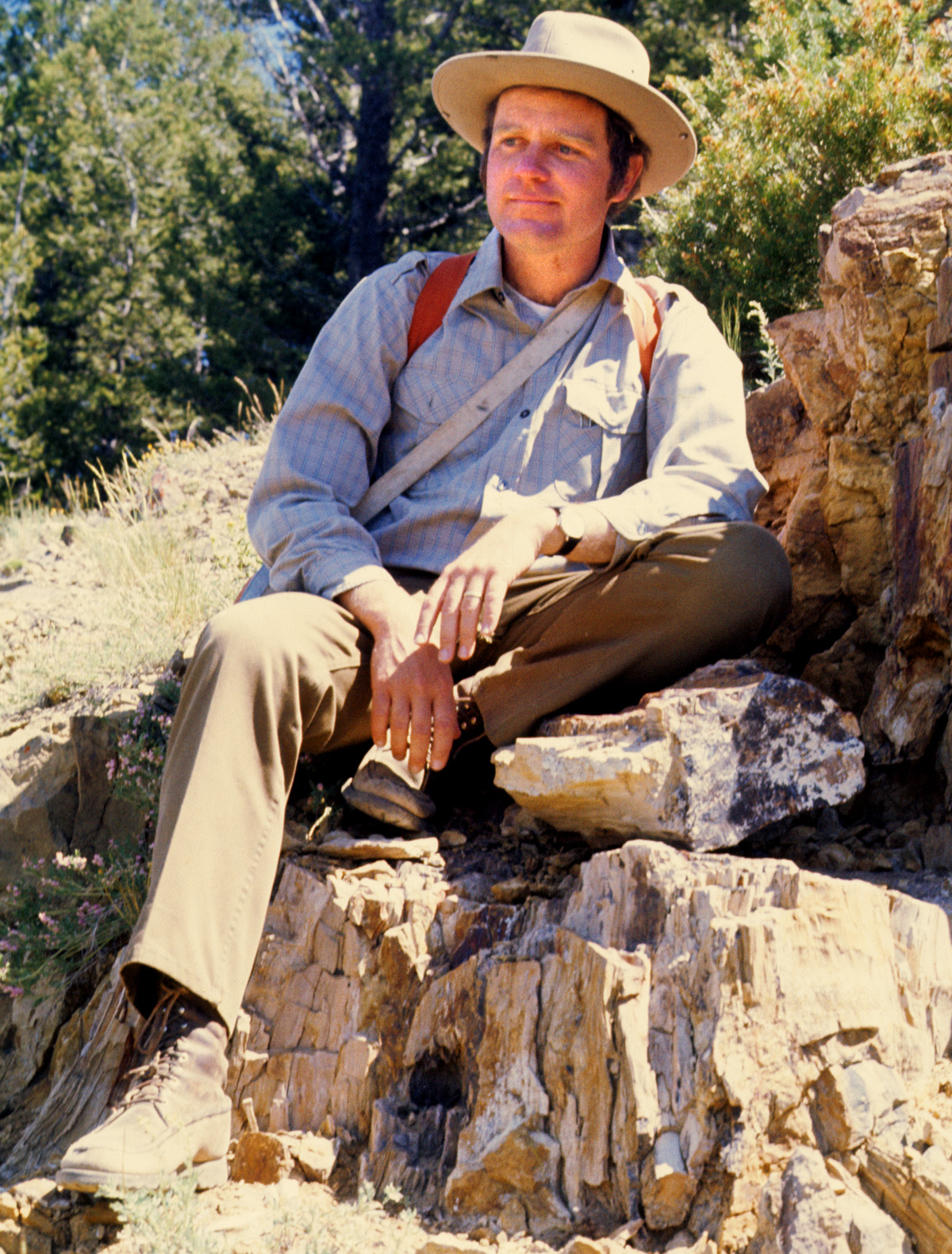 Leo J. Hickey (1940-2013) was a paleobotanist and sedimentary geologist who made major contributions to our understanding of flowering plant evolution and paleoecology, as well as plant extinction and Cenozoic climate change. His insights were shaped strongly by his fieldwork in the Rocky Mountains and Great Plains, the coastal plain of eastern North America, and the Arctic. All applications will be considered for a Hickey Student Research Award, but preference will be given to projects that involve field work on terrestrial fossils and sedimentary systems.
Leo J. Hickey (1940-2013) was a paleobotanist and sedimentary geologist who made major contributions to our understanding of flowering plant evolution and paleoecology, as well as plant extinction and Cenozoic climate change. His insights were shaped strongly by his fieldwork in the Rocky Mountains and Great Plains, the coastal plain of eastern North America, and the Arctic. All applications will be considered for a Hickey Student Research Award, but preference will be given to projects that involve field work on terrestrial fossils and sedimentary systems.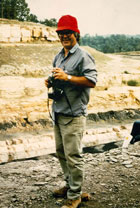 N. Gary Lane (1930-2006) was a leading international authority on fossil crinoids during the 20th century. He completed his Ph.D. research on Mississippian crinoids with R.C. Moore (founder of the Treatise on Invertebrate Paleontology) at the University of Kansas in 1958. He then joined the faculty at UCLA where he rose to the rank of Professor before moving to Indiana University in 1973 so he could be closer to the Mississippian outcrops he so loved. Along with Moore, he was a major contributor to the Crinoidea volumes of the Treatise. Gary published numerous papers and books on crinoid systematics, paleoecology, and evolution, as well as several other topics in paleontology, stratigraphy, the history of geology, and the textbook Life of the Past. He was an innovative thinker and contributed pioneering ideas in benthic community paleoecology. In addition to his scholarly publications, Gary was well known for his love of geologic fieldwork, close comradery with fellow geologists, his nurturing of graduate students, many of whom he inspired to be professors as well, and his encouragement of other echinoderm paleontologists. Among many honors, he was President of the Paleontological Society (1987-1988) and received the R.C. Moore Medal of SEPM (1995). After his retirement in 1995, he remained active, participating in two research expeditions to China that produced several publications. In 2005, a symposium was held in his honor at the Annual Meeting of the Geological Society of America, which led to the book, Echinoderm Paleobiology, published by Indiana University Press.
N. Gary Lane (1930-2006) was a leading international authority on fossil crinoids during the 20th century. He completed his Ph.D. research on Mississippian crinoids with R.C. Moore (founder of the Treatise on Invertebrate Paleontology) at the University of Kansas in 1958. He then joined the faculty at UCLA where he rose to the rank of Professor before moving to Indiana University in 1973 so he could be closer to the Mississippian outcrops he so loved. Along with Moore, he was a major contributor to the Crinoidea volumes of the Treatise. Gary published numerous papers and books on crinoid systematics, paleoecology, and evolution, as well as several other topics in paleontology, stratigraphy, the history of geology, and the textbook Life of the Past. He was an innovative thinker and contributed pioneering ideas in benthic community paleoecology. In addition to his scholarly publications, Gary was well known for his love of geologic fieldwork, close comradery with fellow geologists, his nurturing of graduate students, many of whom he inspired to be professors as well, and his encouragement of other echinoderm paleontologists. Among many honors, he was President of the Paleontological Society (1987-1988) and received the R.C. Moore Medal of SEPM (1995). After his retirement in 1995, he remained active, participating in two research expeditions to China that produced several publications. In 2005, a symposium was held in his honor at the Annual Meeting of the Geological Society of America, which led to the book, Echinoderm Paleobiology, published by Indiana University Press.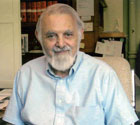 Ellis L. Yochelson (1928-2006) was both a paleontologist and a historian. His paleontological studies centered on Paleozoic mollusks, especially gastropods, but also included scaphopods, chitons, and monoplacophorans. In addition, he proposed the Phylum Agmata, and monographed the Late Cambrian “motorcycle tracks” made by Climacticnites.
Ellis L. Yochelson (1928-2006) was both a paleontologist and a historian. His paleontological studies centered on Paleozoic mollusks, especially gastropods, but also included scaphopods, chitons, and monoplacophorans. In addition, he proposed the Phylum Agmata, and monographed the Late Cambrian “motorcycle tracks” made by Climacticnites.